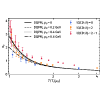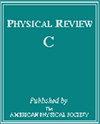Thermal production of charm quarks in relativistic heavy-ion collisions
IF 3.4
2区 物理与天体物理
Q1 Physics and Astronomy
引用次数: 0
Abstract
We investigate the thermal production of charm quarks in the strongly interacting quark-gluon plasma (sQGP) created in heavy-ion collisions at relativistic energies. Our study is based on the off-shell parton-hadron-string dynamics (PHSD) transport approach describing the full time evolution of heavy-ion collisions on a microscopic basis with hadronic and partonic degrees of freedom. The sQGP is realized within the effective dynamical quasiparticle model (DQPM) which is adjusted to reproduce the lattice quantum chromodynamics (lQCD) results for the thermodynamic observables of the sQGP. Relying on the fact that the DQPM successfully describes the spatial diffusion coefficients from the lQCD, which control the interaction of charm quarks with thermal partons (expressed in terms of strongly interacting off-shell quasiparticles), we evaluate the production of charm quark pairs through the rotation of Feynman diagrams such that the incoming charm quark and outgoing light parton in elastic scattering diagrams are exchanged. The charm quark annihilation is realized by detailed balance. We find that the number of produced thermal charm quark pairs strongly depends on the charm quark mass in the QGP. While for the heavy charm quarks of mass it is subdominant compared to the primary charm production by binary nucleon-nucleon collisions at BNL Relativistic Heavy Ion Collider (RHIC) and CERN Large Hadron Collider (LHC) energies, the numbers of primary and thermal charm quarks become comparable for a smaller (bare) . Compared with the experimental data on the of mesons in heavy-ion collisions at RHIC and LHC energies, it is more favorable for charm quarks in the QGP to gain additional mass due to thermal effects rather than to have a low bare mass.

相对论重离子碰撞中粲夸克的热生成
我们研究了在相对论能量下重离子碰撞中产生的强相互作用夸克-胶子等离子体(sQGP)中粲夸克的热生成。我们的研究基于壳外部分子-中子-弦动力学(PHSD)传输方法,该方法在微观基础上描述了重离子碰撞的全时间演化,具有强子和部分子自由度。sQGP是在有效的动力学准粒子模型(DQPM)中实现的,DQPM经过调整以重现sQGP热力学观测指标的晶格量子色动力学(lQCD)结果。DQPM 成功地描述了 lQCD 中的空间扩散系数 Ds(它控制着粲夸克与热粒子(以强相互作用的壳外准粒子表示)的相互作用),基于这一事实,我们通过旋转费曼图来评估粲夸克对的产生,即弹性散射图中传入的粲夸克和传出的轻粒子进行交换。粲夸克湮灭是通过详细平衡实现的。我们发现,产生的热粲夸克对的数量在很大程度上取决于 QGP 中粲夸克的质量。对于质量为 mc=1.8GeV 的重粲夸克,与在 BNL 相对重离子对撞机(RHIC)和欧洲核子研究中心大型强子对撞机(LHC)能量下通过二元核子-核子对撞产生的原初粲夸克相比,原初粲夸克和热粲夸克的数量在更小(裸)的 mc=1.2GeV 时变得不相上下。与 RHIC 和 LHC 能量下重离子对撞中 D 介子的 RAA 实验数据相比,QGP 中的粲夸克由于热效应而获得额外质量比具有较低的裸质量更为有利。
本文章由计算机程序翻译,如有差异,请以英文原文为准。
求助全文
约1分钟内获得全文
求助全文
来源期刊

Physical Review C
物理-物理:核物理
CiteScore
5.70
自引率
35.50%
发文量
0
审稿时长
1-2 weeks
期刊介绍:
Physical Review C (PRC) is a leading journal in theoretical and experimental nuclear physics, publishing more than two-thirds of the research literature in the field.
PRC covers experimental and theoretical results in all aspects of nuclear physics, including:
Nucleon-nucleon interaction, few-body systems
Nuclear structure
Nuclear reactions
Relativistic nuclear collisions
Hadronic physics and QCD
Electroweak interaction, symmetries
Nuclear astrophysics
 求助内容:
求助内容: 应助结果提醒方式:
应助结果提醒方式:


